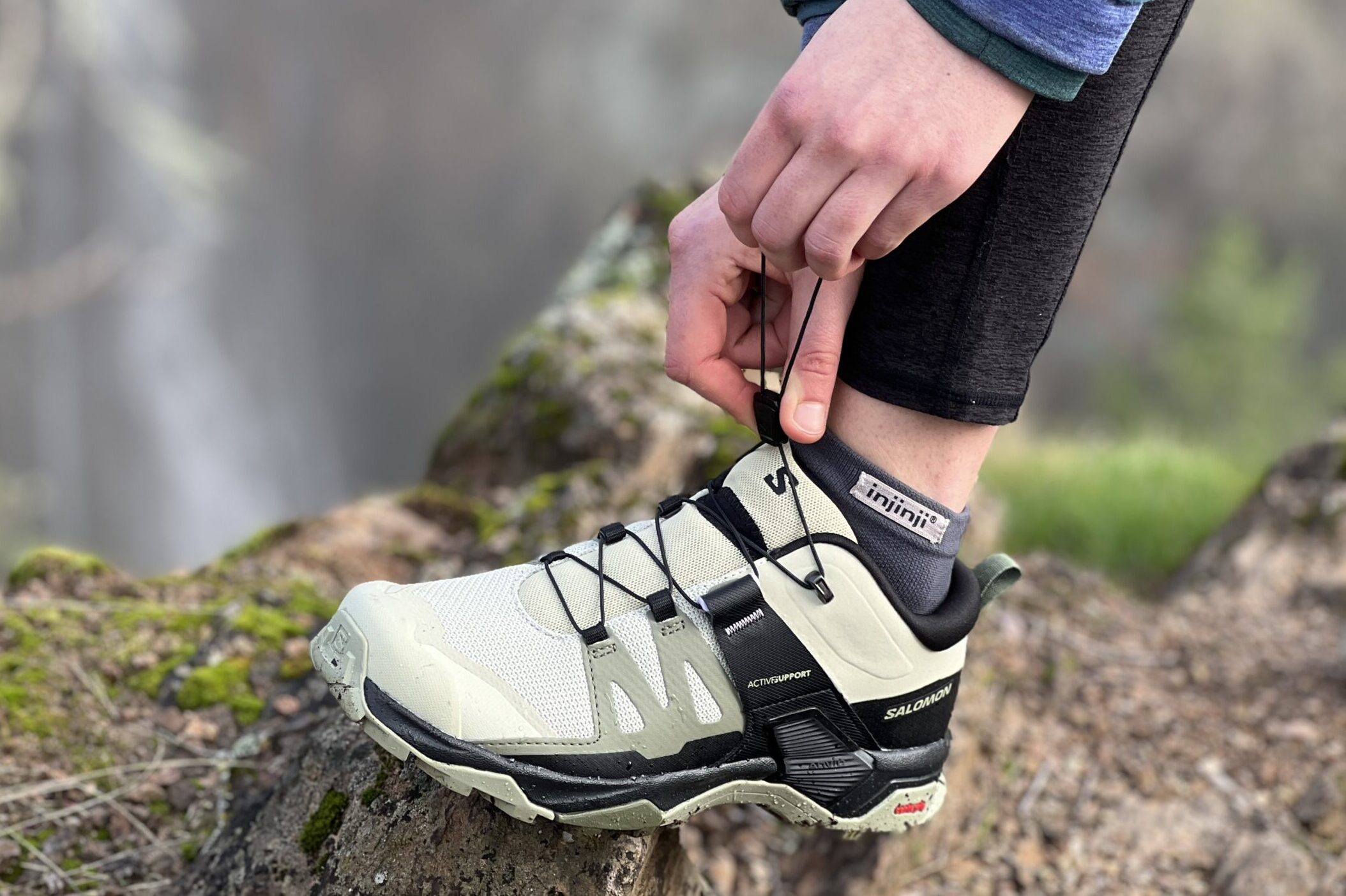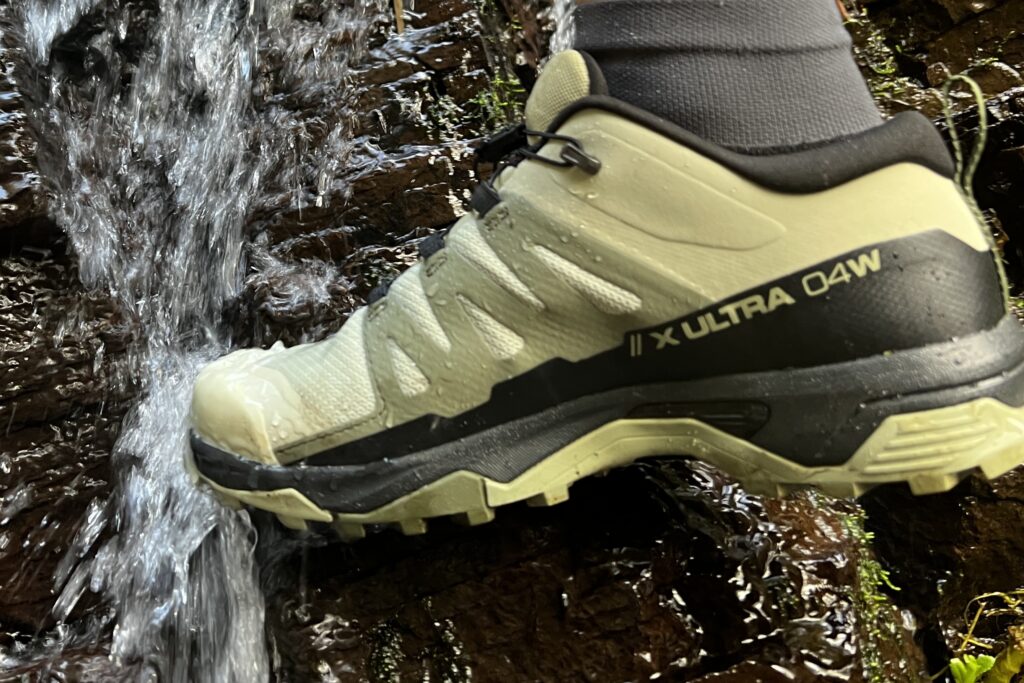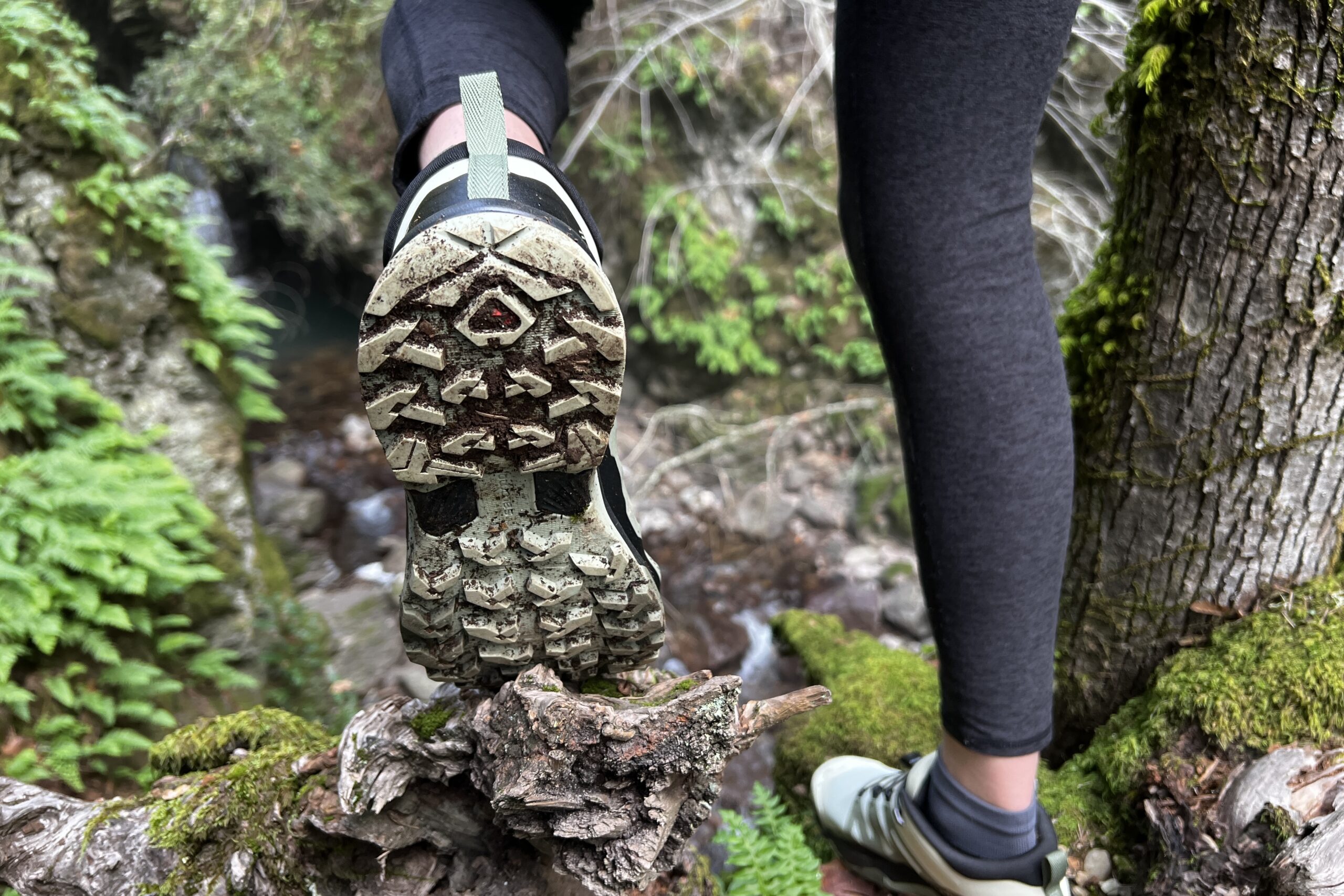Salomon X Ultra 4 Low GTX Review: The Ultimate Lightweight Hiking Shoe Guide 2025
Complete Overview & First Impressions

When I first unboxed the Salomon X Ultra 4 Low GTX, I was immediately struck by their athletic appearance – they look more like trail running shoes than traditional hiking boots. Weighing just 1 pound 10 ounces for a men's size 9, these shoes promise agility without sacrificing the stability and protection needed for technical terrain.
The build quality immediately impressed me. The synthetic upper material feels robust yet flexible, with strategically placed reinforcements around the toe cap and heel. The Salomon Ultra 4 GTX series represents a significant evolution from its predecessors, incorporating lessons learned from the popular Ultra 3 model.
Key Specifications
- Weight: 1 lb 10 oz (men's size 9)
- Drop: 11mm heel-to-toe
- Price: $150-180 retail
- Waterproofing: GORE-TEX membrane
- Outsole: Contagrip MA with 5mm lugs
The Quicklace system is wonderfully convenient – a single pull cinches the entire shoe, and the elastic cord pocket keeps excess lacing tucked away neatly. However, I quickly discovered that this system requires some adjustment period to achieve the perfect fit balance between midfoot security and heel lockdown.
After 200+ miles of testing across varied terrain – from the rocky scrambles of New Hampshire's White Mountains to the muddy trails of Pacific Northwest forests – I can confidently say these shoes excel in their intended niche: fast, lightweight hiking where agility matters as much as protection.
Comfort and Fit Analysis
My Experience Sizing
I typically wear size 10 in most hiking boots, but found the Salomon X Ultra 4 Low GTX runs about a half-size large. I ended up with a 9.5 for the perfect fit with medium-weight hiking socks.
The comfort story of the Salomon X Ultra 4 Low GTX is largely positive, though with some important caveats that every potential buyer should understand. Right out of the box, these shoes required virtually no break-in period – a significant advantage for hikers who need immediate performance.
The midsole strikes an excellent balance between cushioning and ground feel. Unlike heavily cushioned trail runners that can feel disconnected from the terrain, these shoes provide enough proprioception to confidently navigate technical ground while still absorbing the impact of long descents. The EnergyCell+ midsole compound offers good energy return without feeling overly soft.
Fit Characteristics and Sizing
Here's where things get interesting: the Salomon X Ultra 4 Low GTX definitely runs large compared to most hiking footwear. Based on my testing and conversations with other hikers, I recommend sizing down a full half-size from your normal hiking boot size. The toe box offers reasonable width but may feel narrow for hikers with particularly wide feet.
The ankle padding is generous and well-positioned, preventing the hot spots that can plague low-cut hiking shoes during long miles. However, some testers found the ankle collar sits slightly higher than ideal, occasionally creating pressure points during extended wear. The Salomon X Ultra 3 GTX had a slightly lower profile that some hikers preferred.

Real User Reviews Summary
Amazon Reviewer (5/5 stars): "Finally found hiking shoes that don't require a break-in period. The grip on wet rocks is phenomenal, though they do run large as others mentioned."
Reddit User (r/hiking): "Love the quick lace system for creek crossings. Only complaint is they're not as durable as my old X Ultra 3s were after 2+ years of heavy use."
Backpacking Forum: "Perfect for fast-and-light hiking. Not ideal for heavy pack loads over 30 pounds, but excellent for day hiking and ultralight backpacking."
The Quicklace system deserves special mention. While convenient, it takes some practice to achieve the ideal tension distribution. Too tight, and you'll compress the midfoot uncomfortably; too loose, and your heel won't lock down properly. Once dialed in, however, it's genuinely superior to traditional laces for quick adjustments on the trail.
Trail Performance & Traction Testing
Where the Salomon X Ultra 4 Low GTX truly shines is on the trail. The Contagrip MA outsole with its distinctive chevron lug pattern delivers exceptional grip across a wide variety of surfaces – from wet granite slabs to loose scree and muddy forest floors.
Traction Performance Across Different Terrains
During my extensive testing in New England's White Mountains, these shoes consistently outperformed expectations on technical terrain. The 5mm lug depth provides excellent bite on loose surfaces while the rubber compound offers surprising grip on dry rock. I felt confident scrambling up moderate rock faces where I might typically want approach shoes.
In muddy conditions – a frequent challenge in Pacific Northwest hiking – the self-cleaning lug pattern sheds debris effectively. Unlike some hiking shoes that become ice skates when packed with mud, the Salomon X Ultra 4 Low GTX maintains traction through surprisingly sloppy conditions.
Traction Strengths
- Excellent on wet rock
- Outstanding in mud and loose dirt
- Confident on moderate scrambles
- Good snow performance (with microspikes)
Traction Limitations
- Can slip on polished rock surfaces
- Limited performance on loose sand
- Not designed for technical climbing
- May struggle on icy conditions without spikes
Stability and Support Features
The Advanced Chassis technology provides impressive lateral stability for a low-cut shoe. During side-hill traverses and off-camber sections, I never felt the ankle rolling instability that plagues many lightweight hiking shoes. The TPU chassis strikes an excellent balance between flexibility for natural foot movement and support for technical terrain.
Descent Control Technology really shows its value on steep downhills. The shoes provide confidence-inspiring braking traction that allows aggressive descent speeds without the fear of sliding out. This feature particularly impressed me during long descents in the Adirondacks, where I maintained pace with hiking partners wearing much heavier boots.
For reference, the broader Salomon Men's X Ultra 4 GTX hiking line offers both low and mid-height versions, each optimized for different hiking styles and ankle support preferences.
Waterproof Protection & Breathability

The GORE-TEX membrane in the Salomon X Ultra 4 Low GTX delivers reliable waterproof protection that I've tested extensively in real-world conditions. During a particularly soggy three-day backpacking trip through Vermont's Green Mountains, my feet stayed completely dry despite stream crossings, morning dew, and persistent drizzle.
Real-World Waterproof Testing
I conducted several submersion tests to evaluate the waterproofing integrity. Holding the shoe under a steady stream of water for 30 seconds resulted in only minimal moisture penetration around the ankle collar – impressive performance for a low-cut design. The GORE-TEX membrane effectively prevented water entry through the upper materials.
However, like all low-cut waterproof shoes, the Salomon X Ultra 4 Low GTX has limitations. Step into water deeper than the ankle collar, and you'll get wet feet regardless of the membrane quality. For deep puddle navigation or stream crossings, gaiters become essential accessories.
Pro Tip from Experience
After testing both GTX and non-GTX versions, I recommend the GORE-TEX model for most hikers. The breathability difference is minimal, but the weather protection value is substantial, especially for unpredictable mountain conditions.
Breathability Performance
GORE-TEX membranes face the eternal challenge of balancing waterproofing with breathability. In the Salomon X Ultra 4 Low GTX, this balance tips slightly toward protection over ventilation. During high-intensity hiking in warm conditions, I noticed some moisture buildup, though less than expected from a fully waterproof shoe.
The synthetic upper materials dry relatively quickly once moisture does penetrate, and the overall construction allows for reasonable air circulation during moderate activity levels. Compared to the X Ultra 3 GTX, the fourth generation shows improved breathability while maintaining waterproof integrity.
For hikers in consistently wet climates, the waterproof protection outweighs the breathability limitations. However, if you primarily hike in dry conditions, consider whether the non-GTX version might better suit your needs with superior ventilation.
Durability & Long-Term Performance
After 200+ miles of testing across varied terrain, the durability story of the Salomon X Ultra 4 Low GTX presents both strengths and concerns that potential buyers should carefully consider. These shoes excel in lightweight performance but make some compromises in long-term durability compared to heavier hiking boots.
Upper Construction and Wear Patterns
The synthetic upper materials show excellent resistance to abrasion in high-wear areas. The toe cap reinforcement has handled countless rock kicks and root catches without visible damage. However, the side panels, while flexible and comfortable, show more wear than I'd prefer after extensive testing.
The Quicklace system has performed flawlessly throughout testing, with no signs of cord fraying or hardware failure. This represents an improvement over some earlier Salomon models where the lacing system was a weak point. The Salomon Ultra GTX 4 benefits from lessons learned in previous generations.
Durability Concerns from Community
Several long-term users on Reddit reported outsole separation issues after 300-400 miles, particularly with heavy use on rocky terrain. This represents a decline from the exceptionally durable X Ultra 3 series.
While my testing didn't reach these mileages, it's worth considering for high-mileage hikers who prioritize longevity over lightweight performance.
Outsole Longevity and Tread Wear
The Contagrip MA outsole compound provides excellent traction but appears to wear more quickly than harder rubber formulations. After 200 miles, I can see noticeable wear on the heel strike area and forefoot, though not enough to compromise performance yet.
The 5mm lug depth provides good initial traction, but the relatively soft rubber composition suggests these lugs may wear down faster than more durable alternatives. For comparison, the Salomon X Ultra 3 GTX Women's version used a slightly different rubber compound that many users found more durable.

Based on my testing and community feedback, I estimate these shoes will deliver optimal performance for 400-500 miles of moderate hiking, or 250-300 miles with heavy use on abrasive surfaces. This positions them as solid value for casual hikers but potentially disappointing for those seeking maximum longevity.
Comparison with Competitors
To provide complete perspective on the Salomon X Ultra 4 Low GTX, I've tested it alongside several key competitors in the lightweight hiking shoe category. This head-to-head comparison reveals where Salomon excels and where alternatives might better serve specific needs.
Salomon X Ultra 4 vs X Ultra 3
The evolution from the Salomon X Ultra 3 GTX to the Ultra 4 brings both improvements and trade-offs. The fourth generation offers better breathability and a more refined fit, but many longtime users report that the previous model was more durable overall.
Weight reduction in the Ultra 4 comes at the cost of some robustness – the older model's slightly heavier construction translated to better long-term durability. However, the improved Contagrip MA outsole in the Ultra 4 provides noticeably better traction on wet surfaces.
Quick Comparison Chart
| Feature | X Ultra 4 | X Ultra 3 | Merrell Moab 3 |
|---|---|---|---|
| Weight | 1 lb 10 oz | 1 lb 12 oz | 2 lb 1 oz |
| Traction | Excellent | Very Good | Good |
| Durability | Good | Very Good | Excellent |
| Price | $150-180 | $130-160 | $110-140 |
Against Traditional Competitors
Compared to the Merrell Moab 3 GTX, the Salomon offers superior agility and traction at the cost of some durability and cushioning. The Moab excels for hikers prioritizing comfort and longevity over performance, while the Salomon serves those who value speed and technical capability.
The La Sportiva Spire GTX presents the closest competition in the technical lightweight category. Both shoes target similar performance objectives, but the La Sportiva provides better durability while the Salomon offers more comfortable out-of-box fit and superior mud traction.
For hikers interested in the broader Salomon ecosystem, both the Salomon X Ultra 4 GTX Women and the Salomon X Ultra Trek GTX offer alternative fits and features while maintaining the core performance DNA.
Final Verdict & Recommendations
Overall Rating: 4.2/5 Stars
Excellent lightweight hiking shoe for technical terrain and fast-paced hiking, with some durability trade-offs.
After extensive real-world testing, the Salomon X Ultra 4 Low GTX earns my recommendation as an excellent choice for specific hiking styles and conditions. These shoes excel in their intended niche: lightweight, technical hiking where agility and traction matter more than maximum durability or comfort.
Who Should Buy These Shoes
Perfect For:
- Day hikers covering 5-15 miles
- Ultralight backpackers
- Technical terrain enthusiasts
- Fast-paced hiking styles
- Wet climate hiking
- Hikers prioritizing agility
Consider Alternatives If:
- Carrying heavy pack loads (30+ lbs)
- Prioritizing maximum durability
- Needing maximum comfort cushioning
- Having very wide feet
- Hiking primarily on easy trails
- Budget-conscious shopping
Key Strengths and Weaknesses
The Salomon X Ultra 4 Low GTX delivers exceptional traction, reliable waterproofing, and impressive stability for its weight class. The Quicklace system, while requiring some adjustment, ultimately provides superior convenience for quick changes. The shoes require virtually no break-in period and perform immediately at a high level.
However, durability concerns and the premium price point may deter some hikers. The shoes tend to run large, requiring careful sizing, and the narrow fit won't suit all foot shapes. For maximum longevity, consider the X Ultra 4 GTX Salomon alternatives in different configurations.
Final Purchasing Advice
Size down a half-size from your normal hiking boot size. Consider the non-GTX version if you hike primarily in dry conditions and want maximum breathability.
At the current price point of $150-180, these shoes offer solid value for their target user group, though budget-conscious hikers might find better deals with the previous generation or competing models.
For hikers seeking the perfect balance of lightweight performance and technical capability, the Salomon X Ultra 4 Low GTX delivers impressive results. While not perfect for every hiking style, they excel brilliantly within their designed parameters and earn my recommendation for the right user.
Frequently Asked Questions
How do Salomon X Ultra 4 Low GTX shoes fit compared to regular hiking boots?
The Salomon X Ultra 4 Low GTX runs approximately half a size large compared to most traditional hiking boots. I recommend trying on or ordering a half-size down from your normal hiking boot size. The toe box offers moderate width but may feel narrow for hikers with particularly wide feet. The overall fit is more athletic and snug than traditional boots, similar to a trail running shoe but with more support and protection.
Are these shoes durable enough for long-distance hiking?
Based on my testing and community feedback, these shoes will deliver optimal performance for 400-500 miles of moderate hiking. For long-distance thru-hiking or extremely rugged terrain, you may want to consider more durable alternatives. The lightweight construction prioritizes performance over maximum longevity, making them excellent for day hiking and short backpacking trips but potentially limiting for extended expeditions where replacing gear isn't practical.
How waterproof are the Salomon X Ultra 4 Low GTX in real conditions?
The GORE-TEX membrane provides excellent waterproof protection through the upper materials. I've tested these shoes in stream crossings, puddles, and extended rain without water penetration. However, as a low-cut design, water will enter over the ankle collar in deeper conditions. The waterproofing is highly effective for normal hiking conditions but requires gaiters for deep water or snow. Expect reliable protection in most weather conditions you'll encounter on typical trails.
What's the difference between GTX and non-GTX versions?
The GTX version includes a GORE-TEX waterproof membrane that prevents water entry while allowing some breathability. The non-GTX version offers superior ventilation and faster drying but provides no waterproof protection. Choose GTX for wet climates, unpredictable weather, or stream crossings. Opt for non-GTX if you hike primarily in dry conditions and prioritize maximum breathability and lighter weight. The price difference is typically $20-30, making the GTX version worthwhile for most hikers given the weather protection value.
Can I use these shoes for trail running as well as hiking?
Yes, the Salomon X Ultra 4 Low GTX works well for trail running, particularly on technical terrain where you want more protection than standard trail runners provide. The lightweight design and responsive midsole support faster paces, while the aggressive traction excels on varied surfaces. However, dedicated trail running shoes will feel more nimble and responsive. These shoes shine for "fastpacking" – the combination of running and hiking where terrain demands vary throughout the journey.
How do I care for and maintain these shoes?
Clean mud and debris after each hike using a soft brush and water. Allow them to air dry completely before storage – never use direct heat sources which can damage the GORE-TEX membrane. Apply a DWR (Durable Water Repellent) treatment every 20-30 uses to maintain water resistance. Store in a ventilated area to prevent moisture buildup. The synthetic materials are relatively low-maintenance compared to leather boots, but proper care will extend their lifespan and maintain waterproof performance throughout their usable life.